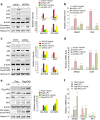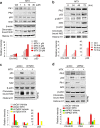Plk2-mediated phosphorylation and translocalization of Nrf2 activates anti-inflammation through p53/Plk2/p21cip1 signaling in acute kidney injury
- PMID: 35842499
- PMCID: PMC10425522
- DOI: 10.1007/s10565-022-09741-1
Plk2-mediated phosphorylation and translocalization of Nrf2 activates anti-inflammation through p53/Plk2/p21cip1 signaling in acute kidney injury
Abstract
The Plk2 is a cellular stress-responsive factor that is induced in response to oxidative stress. However, the roles of Plk2 in acute kidney injury (AKI) have not been clarified. We previously found that Plk2 is an interacting factor of Nrf2 in response to cellular stress, since Plk2 is upregulated in the Nrf2-dependent network. Here, we show that the levels of p53, Plk2, p21cip1, and chromatin-bound Nrf2 were all upregulated in kidney tissues of mice or NRK52E cells treated with either cisplatin or methotrexate. Upregulation of Plk2 by p53 led to an increase of Nrf2 in both soluble and chromatin fractions in cisplatin-treated NRK52E cells. Consistently, depletion of Plk2 suppressed the levels of Nrf2. Of note, Plk2 directly phosphorylated Nrf2 at Ser40, which facilitated its interaction with p21cip1 and translocation into the nuclei for the activation of anti-oxidative and anti-inflammatory factors in response to AKI. Together, these findings suggest that Plk2 may serve as an anti-oxidative and anti-inflammatory regulator through the phosphorylation and activation of Nrf2 to protect kidney cells from kidney toxicants and that Plk2 and Nrf2 therefore work cooperatively for the protection and survival of kidney cells from harmful stresses.
Keywords: Acute kidney injury; Anti-inflammation; Nrf2; Plk2; p53.
© 2022. The Author(s).
Conflict of interest statement
The authors declare no competing interests.
The authors declare no competing interests.
Figures







Similar articles
-
Nrf2-lncRNA controls cell fate by modulating p53-dependent Nrf2 activation as an miRNA sponge for Plk2 and p21cip1.FASEB J. 2019 Jul;33(7):7953-7969. doi: 10.1096/fj.201802744R. Epub 2019 Mar 21. FASEB J. 2019. PMID: 30897343
-
PLK2 protects retinal ganglion cells from oxidative stress by potentiating Nrf2 signaling via GSK-3β.J Biochem Mol Toxicol. 2021 Aug;35(8):e22815. doi: 10.1002/jbt.22815. Epub 2021 May 28. J Biochem Mol Toxicol. 2021. PMID: 34047419
-
MicroRNA-140-5p attenuated oxidative stress in Cisplatin induced acute kidney injury by activating Nrf2/ARE pathway through a Keap1-independent mechanism.Exp Cell Res. 2017 Nov 15;360(2):292-302. doi: 10.1016/j.yexcr.2017.09.019. Epub 2017 Sep 18. Exp Cell Res. 2017. PMID: 28928081
-
NRF2 and p53: Januses in cancer?Oncotarget. 2012 Nov;3(11):1272-83. doi: 10.18632/oncotarget.754. Oncotarget. 2012. PMID: 23174755 Free PMC article. Review.
-
Targeting the KEAP1-NRF2 System to Prevent Kidney Disease Progression.Am J Nephrol. 2017;45(6):473-483. doi: 10.1159/000475890. Epub 2017 May 13. Am J Nephrol. 2017. PMID: 28502971 Review.
Cited by
-
Acidosis Activates the Nrf2 Pathway in Renal Proximal Tubule-Derived Cells through a Crosstalk with Renal Fibroblasts.Antioxidants (Basel). 2023 Feb 8;12(2):412. doi: 10.3390/antiox12020412. Antioxidants (Basel). 2023. PMID: 36829971 Free PMC article.
-
The inhibition of ZC3H13 attenuates G2/M arrest and apoptosis by alleviating NABP1 m6A modification in cisplatin-induced acute kidney injury.Cell Mol Life Sci. 2025 Feb 22;82(1):86. doi: 10.1007/s00018-025-05596-x. Cell Mol Life Sci. 2025. PMID: 39985591 Free PMC article.
-
DYRK1A-mediated PLK2 phosphorylation regulates the proliferation and invasion of glioblastoma cells.Int J Oncol. 2023 Aug;63(2):94. doi: 10.3892/ijo.2023.5542. Epub 2023 Jun 30. Int J Oncol. 2023. PMID: 37387444 Free PMC article.
-
Network pharmacology combined with molecular docking and dynamics to assess the synergism of esculetin and phloretin against acute kidney injury-diabetes comorbidity.Mol Divers. 2025 Feb;29(1):1-19. doi: 10.1007/s11030-024-10829-5. Epub 2024 Apr 5. Mol Divers. 2025. PMID: 38578376
-
Polo-like kinase2 regulates renal tubulointerstitial fibrosis via notch signaling pathway in diabetic kidney disease.FASEB J. 2025 Mar 15;39(5):e70455. doi: 10.1096/fj.202402793R. FASEB J. 2025. PMID: 40059448 Free PMC article.
References
-
- Benetatos L, Dasoula A, Hatzimichael E, Syed N, Voukelatou M, Dranitsaris G, Bourantas KL, Crook T. Polo-like kinase 2 (SNK/PLK2) is a novel epigenetically regulated gene in acute myeloid leukemia and myelodysplastic syndromes: genetic and epigenetic interactions. Ann Hematol. 2011;90:1037–1045. doi: 10.1007/s00277-011-1193-4. - DOI - PubMed
Publication types
MeSH terms
Substances
LinkOut - more resources
Full Text Sources
Molecular Biology Databases
Research Materials
Miscellaneous

